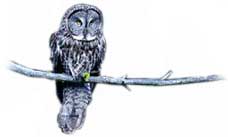|
Twice
in Bible passages, the prophets rely on a naming of birds of eerie cry
or lonely wasteland wandering to help their listeners picture a scene
of utter desolation. Beasts may be named, too — wolves, jackals,
dragons — but the birds alone could set the listeners shivering
in remembered awe as they pictured the sort of lonely place where they
themselves had heard owls hoot and bittern croak, seen vultures gathering
beside sun-bleached bare bones.
Note:
In these quotations, we have left the names of the birds untranslated
since the author translates and identifies the birds in the text.
The ka'ath, named first
in both warnings, is uncertain but it would surely be the stalking scavenger,
the marabou, rather than the pelican named in some old translations. The
cormorant, which may well have shared the name, might also be a bird of
doom, because of its black feathers.

Isaiah 34:11
Kippod, twice
named also, means the "the bristler," and several early translators mistook
it for the porcupine or hedgehog. But birds bristle, too, thought they
do not have spiny quills, and when they are angry enough — or
frightened enough — their feathers stand on end in fearsome
array. The bittern bristles not only in threat or fear, but every time
he brings out that deep-toned croak that echoes across the silent marsh
like a sudden voodoo drumbeat. So of all the birds he is surely the "bristler,"
and his solitary ways second his impact as omen of doom and destruction.
When you take up bittern
watch in some lonely marsh you may think you're hearing a suction pump
instead of a wild bull. First there is an ominous sucking in of breath
to make you imagine a giant pulling his boots out of the ooze, and then
a booming drumbeat, certainly no sound you can duplicate with ordinary
word. If you can hear your first bittern while you are standing alone
in a lonely place, and not want to turn and run, then you must have a
clear conscience indeed.
To top it off, the
bittern's mottled feathering and long neck enable it to pose in veritable
duplication of waving marsh grass, so that you can look right at it and
not see it is there. Then suddenly it moves, seeming to materialize out
of thin air like any ghost — one more reason why the prophets
of old thought their listeners might tremble at a world turned into a
haunt for the bristler…
 Yanshuf,
the horned owl, could be a bird of doom as owls have been in all places
and times. Oreb and ya'annah, the next two birds of doom
in Isaiah's warning are [the] raven and ostrich. Lilith — which
is also the folk name for a certain witch or hag — might be
the ghostly barn owl or the pale Hume's tawny owl that lives in the desert.
The last name on the list — dayyoth — is surely the plural
of da'ah, the kite, another scavenger. But the next to last is
a name that gives translators considerable trouble, for kippoz
is listed among the birds but seems to mean "snake" or "darter." Yanshuf,
the horned owl, could be a bird of doom as owls have been in all places
and times. Oreb and ya'annah, the next two birds of doom
in Isaiah's warning are [the] raven and ostrich. Lilith — which
is also the folk name for a certain witch or hag — might be
the ghostly barn owl or the pale Hume's tawny owl that lives in the desert.
The last name on the list — dayyoth — is surely the plural
of da'ah, the kite, another scavenger. But the next to last is
a name that gives translators considerable trouble, for kippoz
is listed among the birds but seems to mean "snake" or "darter."
If you have followed
bird trails through the Florida Everglades or other southern swamps and
marsh country, you will immediately picture the dark feathers and sinewy
neck of Anhinga anhinga, actually known as both snakebird and darter.
It does look like a snake, for often only the head and neck come thrusting
out from dangling vines or showing above the waves. And "darter" is certainly
the one word to describe the sudden thrusting of [its] slim dagger beak
as the anhinga spears an unwary fish for its dinner.
Like the bittern,
the anhinga is a bird of lonely places and eerie ways that seems like
magic to watchers who do not understand bird life. It can soar on wide
wings like an eagle or a hawk, hang there riding the air currents like
a vulture, dive underwater like a cormorant, and paddle like a duck or
deflate to instant submersion. In tropic lands all around the world, the
anhinga has been counted a bird of special omen. Surely it is a more fitting
denizen for Isaiah's land of desolation than the owls…

Zephaniah 2:14
Zephaniah, in repeating
the same forecast of doom added another name, the kol, the voice.
Of course this could be any ghostly sound, even the wind, but it also
could be the blue roller, known by almost this same word in Israel today.
The roller's voice issues forth from its beautiful blue throat in an unbeautiful
crow-like croak — in fact, "blue crow" or "blue rook" are
some of its nicknames — and like any corvine croak it s to
carry an ominous overtone. Also the roller is a bird that keeps itself
in lonely places.
|
From: Virginia
C. Holmgren, Bird Walk through the Bible,
Copyright © 1972 by
Dover Publications (Mineola,
NY)
pages 68, 70-72. By permission of the publisher.
This book is currently out-of-print. |
BIRDS
Table of Contents
|